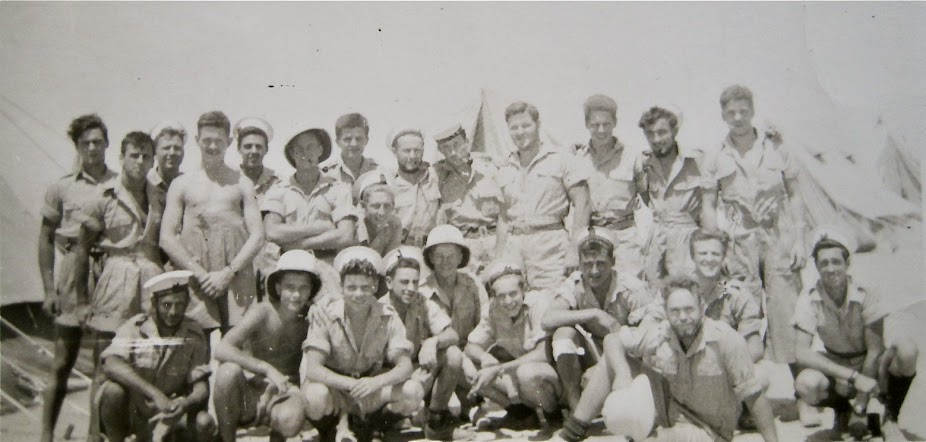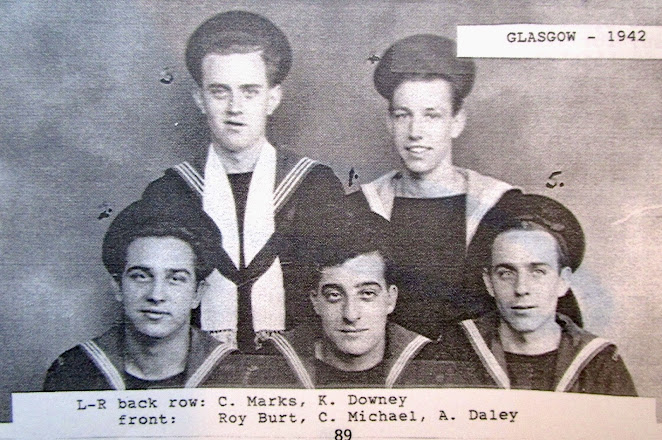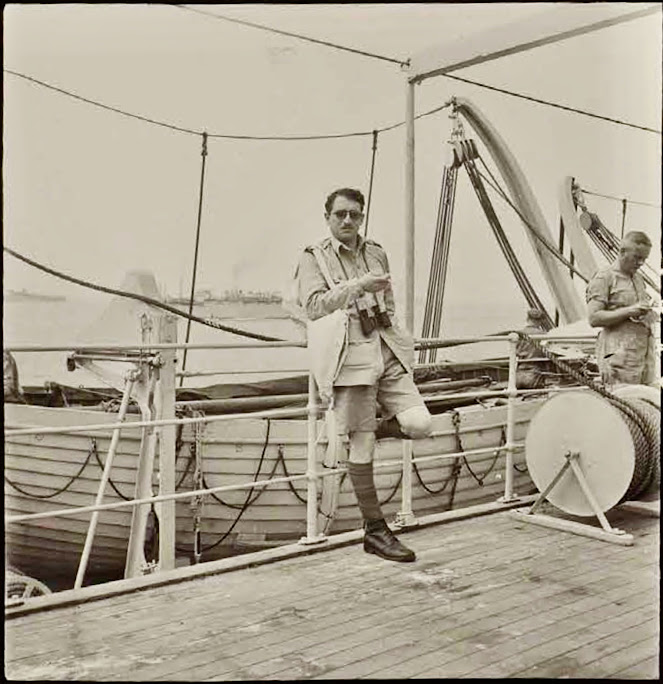Some Photographs from Training Camps in Canada
Other Photos from Egypt and Southern England...
WWII veterans of RCNVR and Combined Operations, present at the 50th
Anniversary of D-Day Normandy Landings, await H.M. Queen Elizabeth
Introduction:
As I look over the 80 photographs in 'the Roy Burt Collection' (given to me by Roy's daughter Laurel Pinske) I realize that Roy travelled many a mile to serve his country during WWII and then, later, when retired, to remember those who served with him.
His training days bear some similarities to my father Doug Harrison, RCNVR/Combined Operations 1941 - 1945 (oft-mentioned in some of the 780 entries - so far - in 1,000 Men, 1,000 Stories) and the rest of the 950 - 1,000 Canadian sailors who volunteered for Combined Ops duties (aboard various-sized landing crafts in most cases) from the raid at St. Nazaire (Operation CHARIOT) in early 1942 to Operations JUBILEE, TORCH, HUSKY, BAYTOWN, AVALANCHE, and NEPTUNE, beginning on June 6, 1944.
Below are a few of Roy's significant photographs and written accounts, accompanied by others from one or two WWII mates:
Above story by Roy Burt is found in a set of two books of WWII (Canadians in Combined Ops) veterans' stories entitled St. Nazaire to Singapore: The Canadian Amphibious War 1941 - 1945 by David and Catherine (Kit) Lewis and Len Birkenes, page 335. Two Books - Please click on Volume 1. Please click on Volume 2.
Underlined in blue above: 'Able Seaman Harry Westbrook' was known as Don or Donnie or Westy by many of his mates, and can be seen in top photo (first on the right) listed as 'Don.'
Underlined in red above: 'Silent Service' - more research is needed, but perhaps some mention was eventually made of Roy's pilgrimage in the Toronto Globe and Mail, or elsewhere. That being said, Roy was not the first to notice that little seemed to be written about the contribution of Canadians who manned landing crafts at St. Nazaire, Dieppe, North Africa, Sicily, and Italy prior to D-Day France. HELP WANTED. Questions or comments or research findings of your own can be emailed to gordh7700@gmail.com
Photographs now follow from "The Roy Burt Collection," along with a few related photos for context:
This photo could have been taken in more than a few places due to Roy's
extensive travels during WWII, e.g., in B.C. before travelling overseas
I believe the next few photographs have a B.C. connection:
The arrow points to Roy Burt, participating in a drill with wooden
rifles (it seems), perhaps as a Navy cadet or young recruit
A young man still, with lots of hair, perhaps at a Navy base (HMCS
Naden?) on The Spit at Comox, Vancouver Island. Note background
The same shoreline in background at HMCS Givenchy III, on The Spit, Comox?
My father (centre) served at a Combined Operations School, from 1944-'45.
Roy Burt shovelling fuel for a coal-burning ship at Comox?
The bay at The (Goose) Spit. Navy base (left), Comox (right), 2015
Lots of oyster beds at The Spit, with a boat at the end of a long pier.
Comox on the left, naval base centre of the spit, from 1930s photo from
the Comox Library Archives. Oyster beds were there into the '40s
Roy Burt at sea, date unknown. Heading to U.K. training camps?
Roy (centre) with two others he trained with in B.C. (far left and far
right). Visit Part 1 and go to photo of men on a swimming dock.
Training camp, location unknown
Training camp, location unknown
Training exercise, location is likely southern coast of England
Roy took part in Operation Neptune, June 1944
Roy (centre) with Canadian mates, could be in southern U.K.
or in Grand Harbour, Valetta, on island of Malta
Seven Canadians in RCNVR and Combined Ops, 1942 or 1943
Back L - R: unknown, C. Dale, Lloyd Evans, Don Westbrook
Front L - R: Don Linder, unknown, Doug Harrison. Location??
From the collection of Lloyd Evans, formerly Markham ONT
Back L - R: unknown, C. Dale, Lloyd Evans, Don Westbrook
Front L - R: Don Linder, unknown, Doug Harrison. Location??
From the collection of Lloyd Evans, formerly Markham ONT
Is this a sample of standard navy haircuts? (Roy is 2nd from front, right side)
These sailors are aboard HMS Keren in June, 1943, "on way to Egypt," below
All the haircuts did not cut the mustard, at least not the C/O's mustard!
Other Canadian sailors aboard HMS Keren, 1943, including Don Westbrook,
and two that Roy knew from B.C., i.e., Jack Rimmer and Harold Tomlinson.
Visit Part 1 and go to photo of men on a swimming dock.
Photo from collection of Doug Harrison, friend of 'Donnie' Westbrook
Two of Roy's mates at HMS Saunders, a Combined Ops Camp near Bitter
Lake, Egypt. Sailor on right - a non-standard haircut under his white cap!
More sailors in 1943 in front of tents at HMS Saunders. E.g., Don Westbrook
in back row, fourth from left; and Harold Tomlinson, front, second from left.
Allied ships, location unknown
Landing crafts churn up the water, location unknown
Canadian war correspondents in Sicilian waters, July 1943
From "They Left the Backdoor Open" by Lionel Shapiro
Roy Burt, in his later years. Photo - K. Lacey Osoyoos Times Nov. 7, 2012
Roy Burt, who settled in Osoyoos 40 years ago to take the job as post master with Canada Post, fondly looks over some personal photographs taken during his time with the Royal Canadian Navy. Burt joined the military as a boy seaman when he was only 17 years old and fondly recalls turning 18 because he was then able to fulfill his dream to fight for his country during the Second World War.
LOCAL VETERAN FONDLY RECALLS TIME SPENT IN COMBINED
OPERATIONS IN SECOND WORLD WAR
Posted by Osoyoos Times
When Roy Burt looks back on his remarkable and rewarding life, his six years as a proud member of the Royal Canadian Navy will always provide many of his fondest memories.
“I wanted to be a soldier since I was a young child so I joined the military when I was 17 years old … next to marrying my wife (Jean) and having kids, it was the best thing I ever did,” said Burt, who, at age 89, looks terrific and possesses a rare ability to remember minute details from his life dating back decades.
Burt is known to many Osoyoosites as the longtime post master with the local Canada Post office. He transferred from Williams Lake in 1972 and worked in Osoyoos until his retirement in 1983.
He came out west to join the navy from his hometown near Hamilton, Ont. and has never left B.C. except for his six years in the armed forces.
With Remembrance Day ceremonies set for this Sunday here in Osoyoos, across Canada and around the world, Burt said November 11 always bring back a flood of memories – some tragic, but most of them good as he met “some of the best people I have ever met in my life was during my time in the navy.”
Burt was a proud member of the Combined Operations – a special team of 900 Canadian and mainly British soldiers who volunteered for “especially hazardous duty” and travelled around the world during the Second World War transporting men and equipment on huge naval landing craft.
“We went everywhere … I got to travel the world and loved every second of it,” said Burt.
After training for months in Scotland and England, Burt’s first active duty was being part of Operation Torch in the north African country of Algiers. He left on Oct. 26, 1942 on a convoy of 50 ships, with half of them headed to Algiers.
A big part of their job was transferring American soldiers to various destinations using small landing craft, he said.
After an extended leave and further training, Burt participated in Operation Husky, which took him and the Combined Operations unit to Sicily in July of 1942. This time, his job was to help transport and transfer British soldiers to shore. Admitting he saw many of his fellow soldiers killed, Burt said he doesn’t like to talk about the losses, but is more than willing to talk about the good work performed by his unit.
Burt and his fellow soldiers from Combined Operations were then called back to Europe in the spring of 1944 and participated in D-Day, one of the most important military operations in history. Military planners had given Canada a major role on D-Day to take one of five designated beaches where Allied forces were to land to begin the liberation of Europe from Nazi Germany. The Americans were designated to take Utah and Omaha Beaches in the west, British soldiers landed at Gold Beach and at Sword in the east, while Canadians landed at Juno Beach.
The greatest seaborne invasion in history was aimed at 80 kilometres of mostly flat, sandy beach along the Normandy coast, west of the Seine River. There were 155,000 soldiers, 5,000 ships and landing craft, 50,000 vehicles and 11,000 planes set for the battle. For Canada, 14,000 soldiers were to land on the beaches, while another 450 were to drop behind enemy lines by parachute or glider. The Royal Canadian Navy supplied ships and 10,000 sailors.
“We did six trips across the channel every day, transporting 300 soldiers at a time … we did that for just over a month,” said Burt.
Being part of that historic event was something he will never forget. “That opened up that part of Europe to the Allied Forces and helped change the course of the war, so it was very important,” he said.
Being able to fight for his country to help defeat the Nazis remains something he’s very proud of, said Burt. “When I joined I was too young to go to sea … I remember how happy I was to turn 18 because I joined the navy because I wanted to fight in the war. That’s why I signed up. I remember telling my band master that I was almost 18 and could finally get on a boat and he finally agreed it was time to leave the band.”
After his time in Normandy, Burt returned to Canada and Halifax when a commander asked who was willing to travel to Japan on the HMCS Algonquin – a destroyer. “Some people can’t keep their hands down or shut their mouth and I couldn’t do either so I was on the move again,” he said smiling. “I loved being in the navy and this was my career and I wanted to keep fighting.”
The ship was halfway across the Pacific Ocean when the crew received word that the war had ended, he said. “I remember it was a very strange sight to see all these other ships with their lights on,” he said. “We had run for months under the cover of darkness and trying to hide from the enemy.”
On the trip home, he and his crew managed some leisure time in Egypt, Jamaica and eventually San Diego, California. “We came back through the Suez Canal … I still remember when we ended up in Jamaica. That was alright,” he said laughing. “We ended up having more than a few cups of rum.”
Considering he had only seen his wife – they got married in the summer of 1944 while he was on leave – a couple of times since tying the knot, Burt decided to retire from the navy on March 15, 1946. “I looked my wife in the eye and told her I had had enough of this navy and I was going to quit,” he said. “I had achieved my dream of fighting in the war and thought it was time to do something else with my life. I loved my life in the navy, I really did, but it was time to move on.”
He and a brother started a successful boat building business near Hamilton following the war, but they shut that down after three years. Burt was then hired at Canada’s largest steel mill (Stelco) in Hamilton and worked there for eight years before deciding the coke dust he was inhaling every day would kill him.
“I loved the job and made some really good money, but I knew my health would never last sucking in those horrible gases every day,” he said. “Me and the wife had a talk and decided we would like to head back out west.”
They intended to go to Victoria, however, they visited a friend of a friend in Penticton and ended up loving that town and called it home for several years. Burt worked at a car dealership for one year before applying for a job with Canada Post in 1956. He worked for the post office in Penticton and Williams Lake before coming to Osoyoos in 1972.
“I took a pay cut to come back to the Okanagan,” he said. “But I had visited Osoyoos many times when I lived in Penticton and remember telling my wife the first time we came here that this is where we would retire.”
Because he has bad knees and can’t sit for extended periods of time, Burt hasn’t attended the local Remembrance Day ceremony the past two years. However, his mind always flashes back to his days in the navy every November 11.
“You don’t ever forget,” he said. “It’s an important day for all of us (veterans). It really is.”
More photographs from the Roy Burt collection will soon follow.
Please click here to view Photographs: The Roy Burt Collection, RCNVR and Combined Operations (1)
Unattributed Photos GH
Please click here to view Photographs: The Roy Burt Collection, RCNVR and Combined Operations (1)
Unattributed Photos GH



































%20copy.jpg)


















